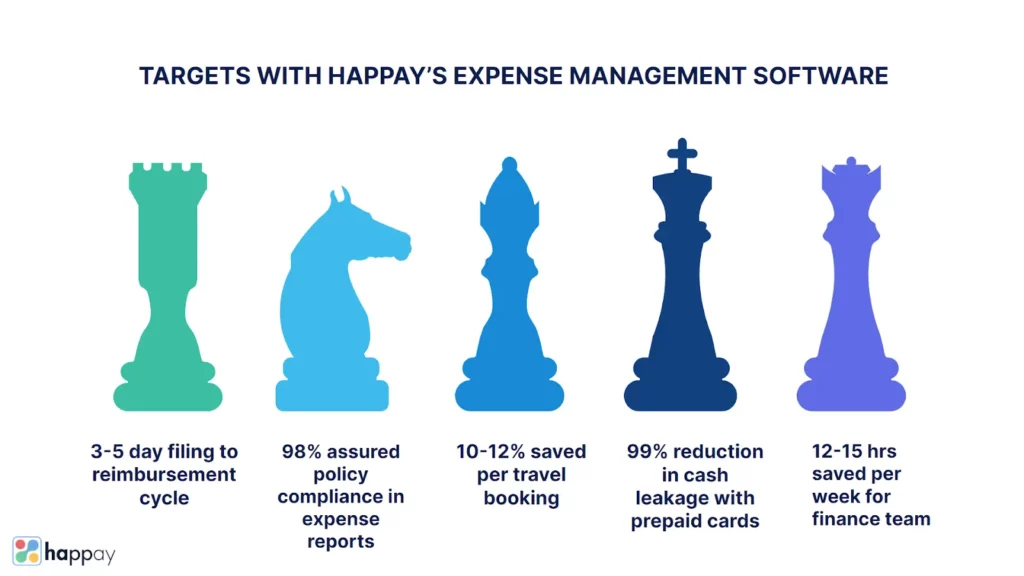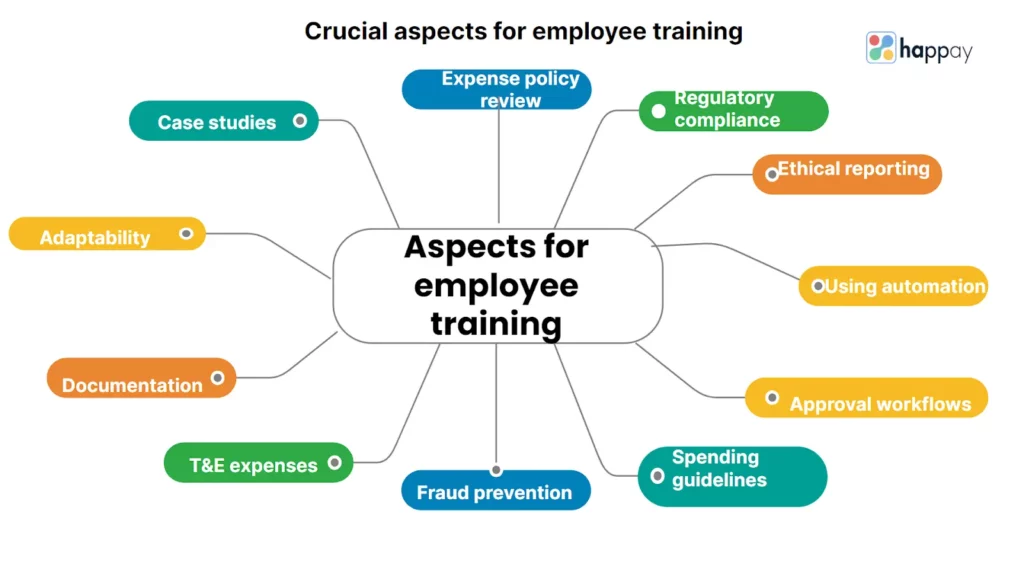Last Updated on December 20, 2025
An expense management policy is a set of regulations and procedures established by an organization to govern the process of incurring, submitting, approving, and reimbursing business-related expenses.
The essence is to align business spending with organizational goals, meticulous compliance with regulations, and focus on cost control.
Suggested reads: Expense management workflow
Significance of optimizing your expense management policy
Optimizing your expense management policy is a crucial necessity, and its significance is evident in the positive impact on the following key parameters.
- Efficient financial management with financial resources allocated judiciously and in alignment with organizational goals.
- Higher degree of compliance and governance as clear guidelines are established for every financial transaction.
- Enhanced cost control and efficiency with streamlined processes, redundancies eliminated, and realistic spending limits.
- Employee empowerment due to clarity on acceptable expenses, approval workflows, and reporting practices.
- Real-time insights made available with technological integration
- Risk mitigation as potential risks associated with expenditures are easily identified.
Let’s explore strategies to optimize the expense management policy.
Suggested reads: Expense Management tips
The top ten strategies to optimize expense management policy
1. Aligning Policies with Organizational Goals
“We’ve all got to ensure we’re all pulling in the same direction. That’s what’s going to keep us ahead of the ball.”
Bubba Wallace
The synergy between expense management policies and organizational goals is a fundamental integration that can significantly contribute to the success and sustainability of your business. Expenditures can be strategically prioritized when companies tether spending practices to organizational goals.
This alignment supports the achievement of broader perspectives and has other key advantages.
- It Optimizes allocation of financial resources
- Enables accurate budgeting
- Minimizes unnecessary expenditures
- Facilitates establishment of KPIs to assess the effectiveness of spending
- Enhances employee engagement and accountability
Understanding the alignment and tailoring policies accordingly
When expense policies align with organizational goals, they can evolve into a symbiotic relationship.
- Strategic prioritization of expenditures based on overarching company goals.
For example, if your business aims to enhance customer satisfaction, the expense policy can prioritize investments in customer service training or technologies to improve the overall customer experience.
- Setting clear spending guidelines in areas critical to the company’s success.
Let’s say the strategic goal is market expansion through innovation. The expense policy can earmark expenditures for R&D activities and define efficient spending guidelines.
- Adaptability to changing business strategies to shift resources with evolving goals.
In a case where the company expands globally, the policy may need adjustments to accommodate international travel expenses or currency considerations.
2. Use technology
The use of technology in monitoring employee reimbursements to track corporate spending can bring significant benefits by streamlining processes, increasing efficiency, and providing real-time insights.
Expense management software
Expense management software is a comprehensive digital solution that automates managing a company’s expenditures, covering tasks from submission and approval to tracking and reporting. These tools provide a secure solution, increasing transparency and operational ease while ensuring global compliance.
Know more about Best Expense management software in India
Happay streamlines processes
Happay’s expense management solution, with its best-in-class features and advanced AI-powered processes, is designed to simplify and optimize the entire expense management process.
Happay’s solution further streamlines the entire expense management process with these tools.

- Happay Xpendite automatically captures expense data from physical bills, emails, cards, cabs, SMSs, and international bills at the source. It gives 100% accurate expense data in record time.
- Happay software integrates with different applications across categories, including ERPs, HRMs, travel agencies, car rentals, credit cards, and more.
- Happay’s SmartAudit automatically flags duplicate invoices, over-claimed expenses, restricted items, and mismatches in GST details.
- Happay’s Self Booking Tool (SBT) helps further streamline flight and hotel bookings
- Happay expense platform provides GST automation in T&E
- Happay prepaid cards are a more innovative alternative to cash advances. Companies can fund them on the fly, track spending in real-time, set limits for spending control, and approve expenses on the go.
Suggested reading: Best wireless expense management software

3. Implementing robust approval workflows
Implementing robust approval workflows enhances the speed of decision-making and contributes to transparency, accountability, and compliance with organizational policies.
Happay’s ApprovNow ensures seamless approval workflows.
Designing and fine-tuning efficient approval processes
Key features to be considered for designing an efficient approval process include:
- Defining approval thresholds for higher-value expense amounts to trigger different levels of approval
- Automating routine approvals for expenses below a certain threshold
- Automating the approval process to access real-time updates, resulting in fastest approval cycles with no policy violations.
- Incorporating parallel approvals expedites the process, especially when time-sensitive decisions are required.
- Establishing escalation protocols to address delays or unavailability of approvers to maintain workflow efficiency.
Incorporating hierarchical approvals, ensuring the approval process aligns with the hierarchical structure and organizational policies.
4. Enhancing Transparency and Communication
For a positive and collaborative workplace culture, enhancing organizational transparency and communication is imperative. Employees must be informed about any changes or updates to organizational policies, especially those related to expense management.
Improving communication channels for policy updates
Establishing and optimizing reliable communication channels, such as newsletters, intranet announcements, or regular company-wide meetings, ensures that employees are promptly informed of policy updates This approach encourages awareness and compliance, prevents misunderstandings, and enables employees to plan their actions per the latest guidelines.
Increasing transparency to foster trust among employees
“ Trust happens when leaders are transparent.”
Jack Welch
Increased transparency is achieved by providing visibility into
- How are policies enforced?
- How are approvals granted?
- How do expenditures align with the company’s goals?
5. Customizing expense categories for precision
Effective expense management requires customizing expense categories to enhance accuracy and clarity in financial reporting. It involves meticulously defining specific and detailed expense categories that align with the nature of your company’s expenditures.
Let’s look at the key impacts of customizing expense categories.
- Granular understanding of expenditures
- Expenses aligned with business operations
- Improved budgeting accuracy
- Streamlined expense tracking
- Compliance and accountability maintained
- Insightful financial data available
Suggested reads: Expense Categories
6. Ensuring compliance with regulations
Ensuring compliance with regulations is a fundamental responsibility that requires a proactive and comprehensive approach. The framework of expense policies must address legal and regulatory considerations.
Suggested Reads: Expense Management Challenges
Addressing legal and regulatory considerations in expense policies
Legal and regulatory compliance is achieved by crafting expense policies that address legal and regulatory considerations pertinent to the industry, jurisdiction, and nature of the company’s operations.
Organizations must create a roadmap for adherence by embedding compliance requirements within the fabric of expense policies. Non-compliance can result in financial penalties, legal consequences, and reputational damage.
Staying Updated on tax implications and reporting requirements
Furthermore, ensuring compliance also encompasses staying current on tax implications and reporting requirements. A dynamic understanding of tax laws is crucial for accurate and timely reporting. For example, certain business expenses are tax-deductible. It can help in optimizing the company’s tax liabilities.
Monitoring tax laws ensures that expense management processes align with current mandates.
Staying updated mitigates the risk of financial penalties, puts the company on the right side of the law, and develops a fiscal responsibility and integrity culture.
7. Continuous monitoring and auditing strategies
“Risk comes from not knowing what you’re doing.”
Warren Buffett
Continuous monitoring and auditing strategies thus become an imperative, not just a best practice.
They offer a vigilant and proactive approach that can sound alarm bells in case of transgressions in expense management policies.
Regular Audits for Proactive Expense Monitoring
Regular audits are essential to proactive expense monitoring, ensuring financial integrity and compliance. They provide the insight required to understand financial activities comprehensively.
Regular expense audits systematically examine financial records, processes, and transactions. It helps businesses identify anomalies, discrepancies, or potential risks, enhancing financial accountability.
Utilizing analytics tools for real-time tracking and analysis
Leveraging analytics tools for real-time expense tracking and analysis helps monitor and quantify expenses as they happen.
They offer immediate insights into spending patterns, trends, and potential deviations from budgets, leading to efficiency in financial management.
Suggested reading: Tactics for Smart Expense Management in Business
8. Employee training for adherence and efficiency
“An investment in knowledge pays the best interest.”
Benjamin Franklin
This quote holds especially true in expense management, where employee training becomes imperative for adherence and efficiency.
Organizations must invest in comprehensive training programs tailored to provide an understanding of policy adherence, legal considerations, and ethical reporting practices. This knowledge catalyzes employees to comply, ensuring expenses incurred and reported align with policies and ethical standards.
Offering comprehensive training programs for employees
Offering comprehensive training programs is a strategic investment to ensure a thorough understanding of policies, procedures, and best practices.

Educating staff on policy adherence and proper reporting practice
Education is pivotal in promoting policy adherence and ethical reporting practices in expense management.
An educated staff is equipped with enhanced knowledge of expense policies and reporting practices, enabling them to
- utilize management tools effectively
- improve efficiency and compliance
- be aware of budgetary constraints
- become fiscally responsible
The comprehensive knowledge empowers employees to adhere to policies, enhance efficiency, and uphold proper reporting practices.
9. Benchmarking against industry best practices
Benchmarking against industry best practices is a strategic approach businesses can employ to elevate their expense management processes. It involves thoroughly examining successful examples from similar businesses and incorporating the best practices to manage expenses efficiently.
Studying successful examples from similar enterprises
A meticulous study of successful examples from similar enterprises in the industry provides valuable insights into effective practices. Examining the strategies and approaches proven effective for peers and competitors helps businesses understand what works within their sector.
This detailed analysis offers a roadmap for understanding benchmarks and standards that define success in your company’s expense management.
Best practices to stay ahead
To stay ahead in expense management, you must proactively incorporate the insights gained from industry benchmarks into your processes. This ensures that your expense management strategies remain adaptive, agile, and current with the sector’s best practices.
Organizations can stay ahead of industry standards by adopting a mindset of continuous improvement, learning from other’s successes, and integrating these insights into their expense management frameworks.
10. Measuring and analyzing key performance indicators (KPIs)
“What gets measured gets managed.”
Peter Drucker
This wisely articulated quote holds even in expense management, highlighting the crucial role of measuring and analyzing Key Performance Indicators as a compass for success.
Identifying relevant KPIs for expense management
First, you identify relevant KPIs tailored to your organization’s needs.
Whether tracking overall spending patterns, evaluating compliance with policies, or assessing approval cycle times, selecting the right KPIs is akin to choosing the compass that guides effective decision-making.
Using KPI data to assess and improve policy effectiveness consistently
Once the relevant KPIs are in place, the real power lies in utilizing the data derived from them to assess and improve policy effectiveness consistently.
The insights derived from KPIs provide a continuous feedback loop, offering an in-depth understanding of policy performance. This iterative assessment allows organizations to identify strengths, address weaknesses, and adapt policies to meet the dynamic demands of the business environment.
Conclusion
“Money saved is money earned.”
Implementing a well-crafted expense management policy is a dual-purpose instrument—a regulatory tool and a strategic guide.
By establishing clear guidelines and developing a culture of compliance, expense management policies mitigate financial risks and contribute to transparency and accountability. Leveraging automation and advanced expense management software further enhances the efficiency and effectiveness of policy implementation.
FAQs
An expense management policy is crucial for businesses because it establishes clear guidelines, ensures regulatory compliance, and provides transparency, accountability, and cost control.
Expense categories should be defined based on the nature of business expenditures. This is crucial for budgeting, financial analysis, and accurate knowledge of spending patterns.
Automate workflows, set clear approval thresholds and utilize technology to streamline the approval process efficiently.
Expense management software automates processes, ensures real-time tracking, and enhances compliance, optimizing policy implementation.
Consequences of non-compliance include financial penalties, reputational damage, and potential disciplinary actions.
Establish clear reimbursement policies, automate processes, and prioritize timely communication for fair and prompt employee reimbursements.
Key performance indicators (KPIs) to monitor include expense-to-revenue ratio, compliance rates, processing time, and variance analysis.










Discussion about this post